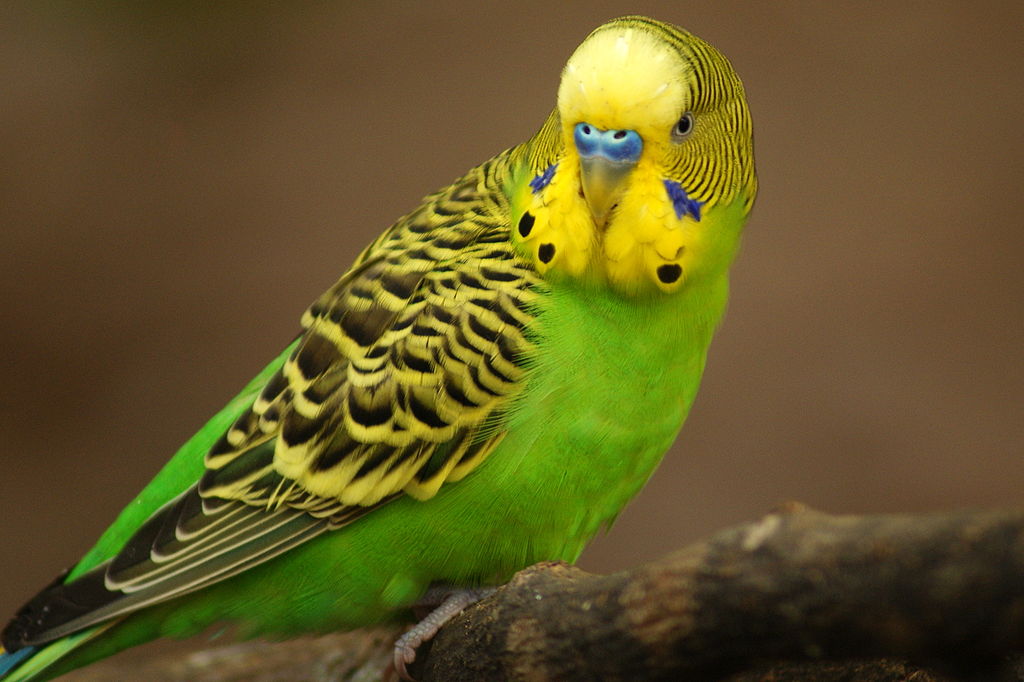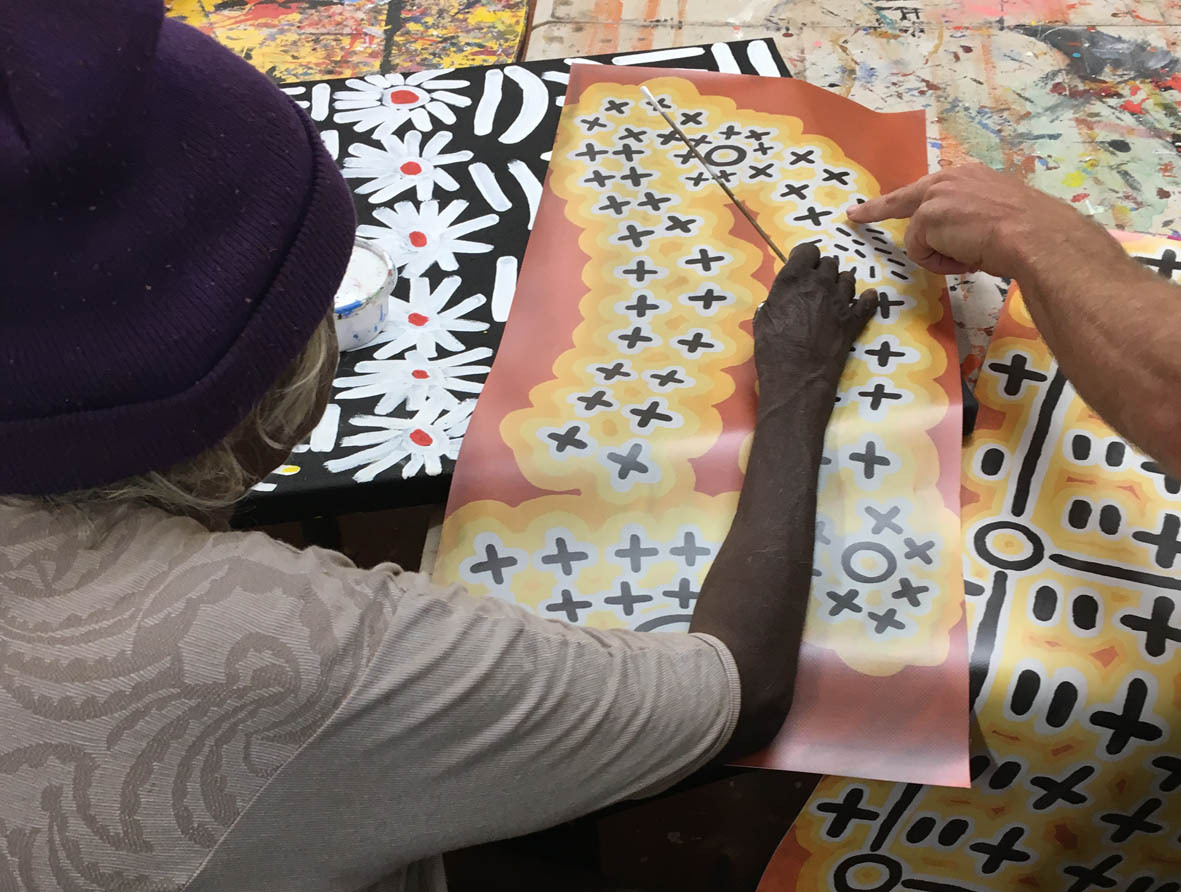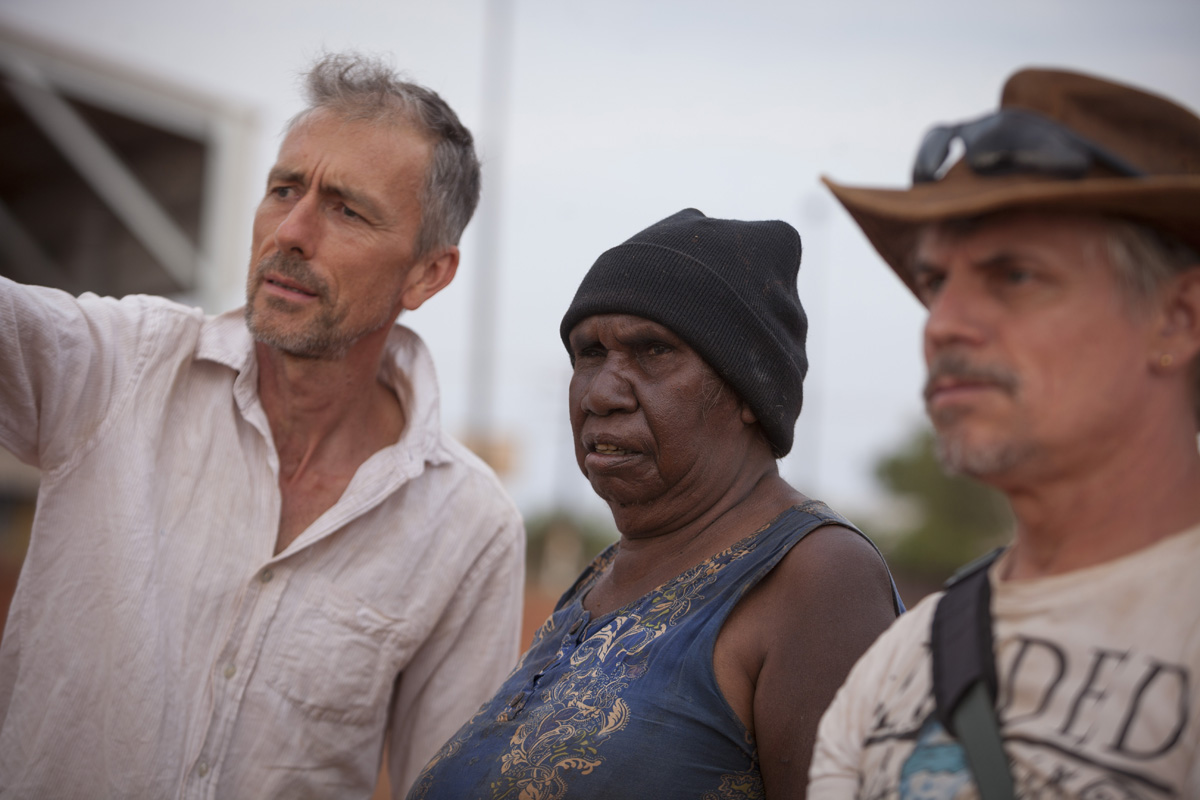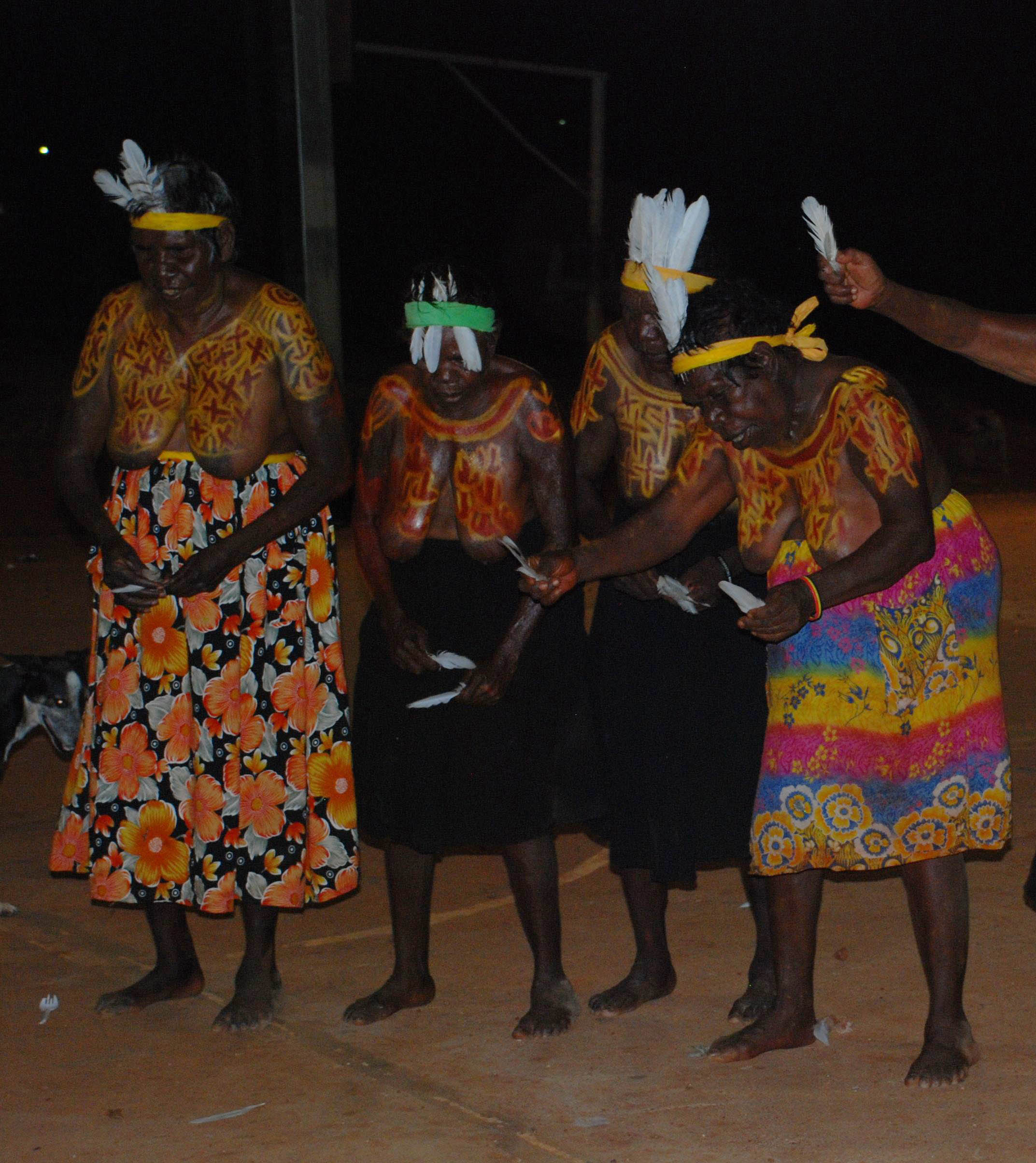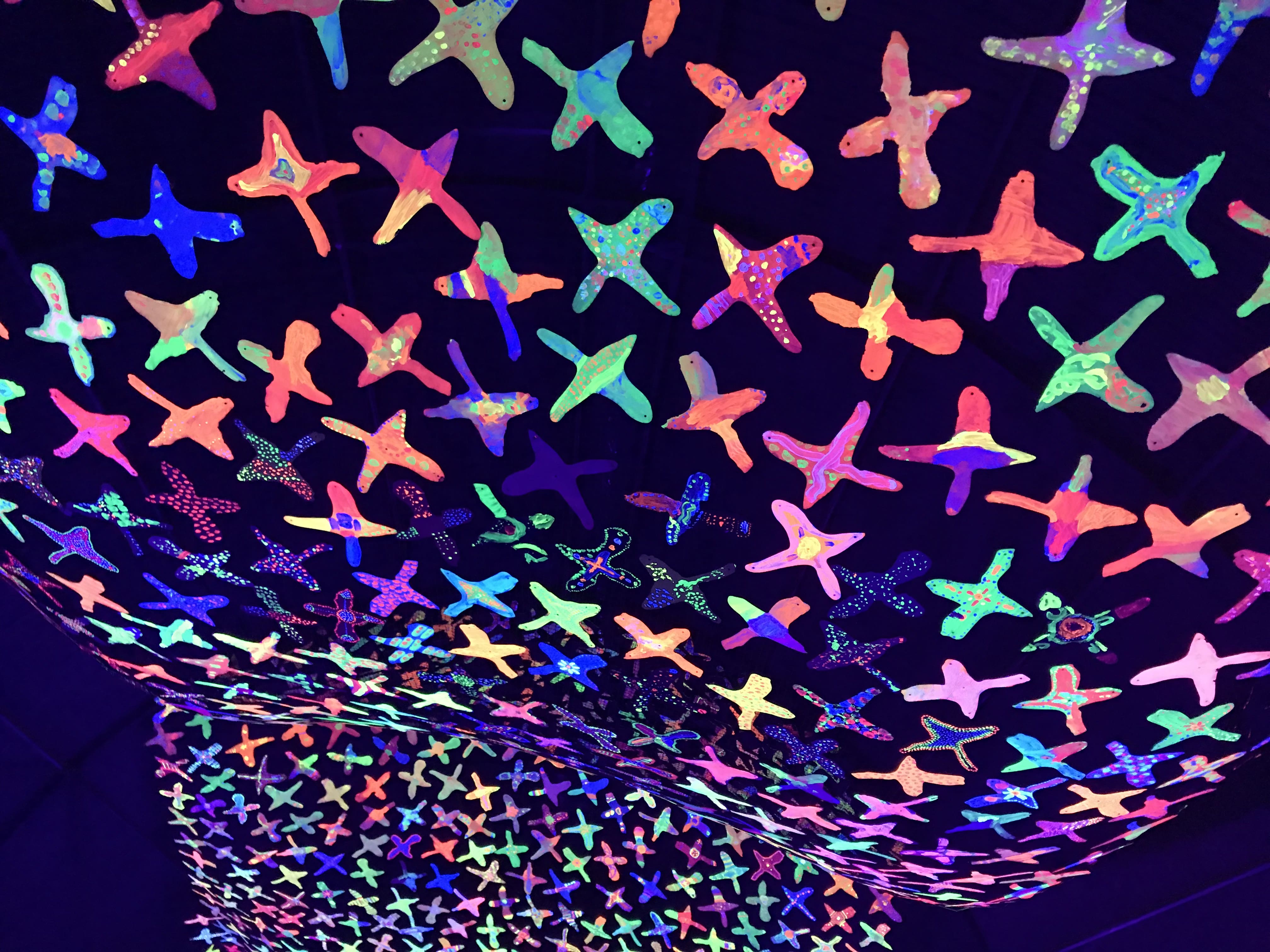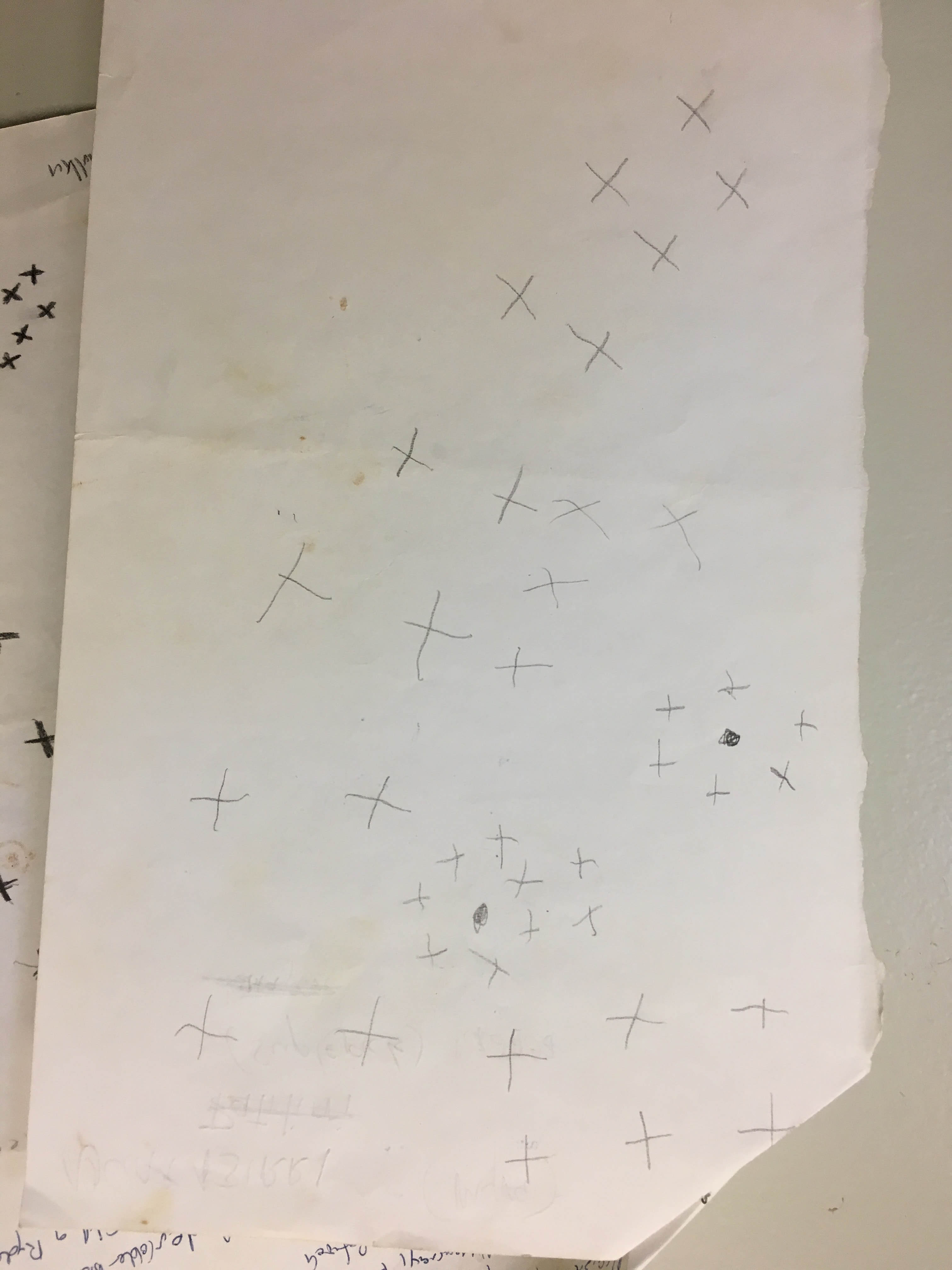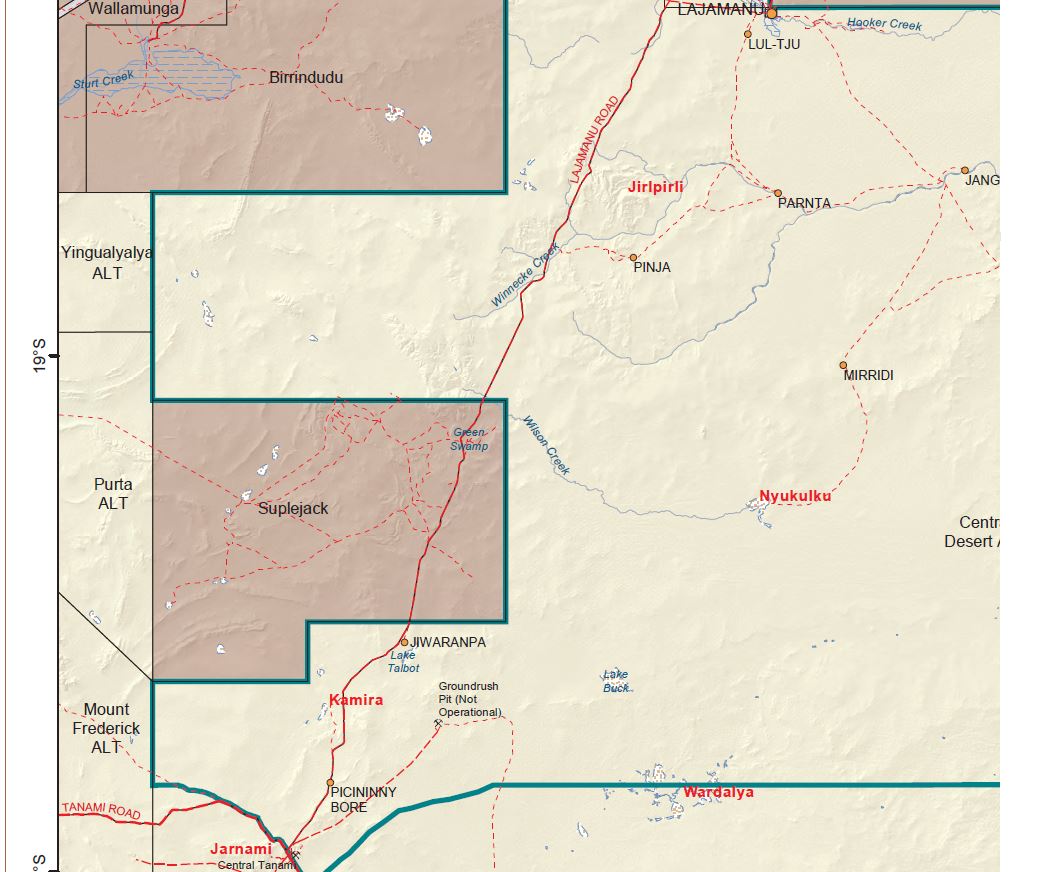Milpirri Banner - NGATIJIRRI (Budgerigar travelling to Tanami)
Dreaming and Design
Ngatijirri (Budgerigar). Traditional Owner and artist for this banner, Myra Nungarrayi Herbert, explains that the crosses in the painting are the tracks of the Ngatijirri bird ancestors and the circles are places they visited. Ngatijirri came from Partilirri to Yinapaka on the Lander River. This banner picks up the story at Nyukulku (the flood-out on Wilson Creek) which is represented by the largest circle on the right hand side. After Nykulku they flew to Kartarta, a sacred rock hole on Wilson Creek. (Kartarta is the small circle top right with the crosses around it). From here the next stop is an area near the Tanami Mine where they dropped a lot of feathers, represented by the dashes in the top left of the banner. A ngalkardi tree near Tanami mine is the next circle (bottom left circle). At this site the Ngatijirri were feeding on wood grubs in the tree. Warlpiri people often point out the sacred tree on their travels up and down the Tanami road. Finally some Ngatijirri returned to Yinapaka while other flew back Nyukulku and on to Kurlingalinpa (Buchanan Hills). The Ngatijirri flew back to Yinapaka (Lake Surprise). Some other Ngatijirri left Nyukulku and went to Kurlingalinpa. The Ngatijirri Dreaming is not generally thought of as a line like some other Dreamings, it is more a series of “spots” marked by places where the Ngatijirri performed an action or dropped feathers.
There is a second Ngatijirri (Budgerigar) Milpirri banner - Photos / Information
Find the Tanami Mine where Ngatijirri dropped her feathers - Map
Find Ngukulku (Wilson Creek Flood Out) where this banner begins its story - Map
Belonging to Skin Groups
Japaljarri, Jungarrayi, Napaljarri and Nungarrayi (Yellow Group)
Drawn by
Myra Nungarrayi Herbert 2012
Family
In Lajamanu learn more about Ngatijirri from Geoffrey Jungarrayi Barnes or Myra Nungarrayi Herbert
Kirda
In Lajamanu for more information about Ngatijirri speak with Myra Nungarrayi Herbert.
Kurdungurlu
Steve Jampijinpa Patrick
Artist Profile
Myra Nungarrayi Herbert, (previously known as Myra Nugarrayi Patrick), was born at Wirliyajarrayi which is the Warlpiri name for Willowra around 1946. She paints Mala, Ngatijirri (Budgerigar), Witi (Pole), Jutiya (Snake), Ngalyipi (Snake Vine), Butcher Bird, and Cockatoo Dreamings. Myra started painting in 1986. Her early work is immediately identifiable by her absolutely minuscule dots, which were part of Myra’s conscious development of her own individualistic style. Minute dots are now a familiar technique, but few have used them with such subtle refinement. She collects tiny twigs and sharpens them to do the dots. She estimates that she takes about five weeks to complete a canvas. By the early ’90s Myra had developed RSI from painting, and was told to quit, but refused. Her current work is of the contemporary style in Lajamanu which mimics the broad brush stroke designs painted on bodies and sacred objects during ceremony. Myra is one of a group of Lajamanu women who has played a critical part in the engagement of Warlpiri culture with mainstream organisations including the Department of Education, the Central Land Council, Tracks Dance Company, and numerous academic institutions. She is a fantastic collaborator with a sharp intellect and a deep creative passion. She is also an expert hunter and has a wide-ranging knowledge of country and traditional song. She is often one of the key women involved in country visits organised with the school and the Lajamanu rangers.
Source: Design and Art Australia Online with additions by Miles Holmes
Latin
Melopsittacus undulatesn
Traditional Hunting
Ngatijirri are small, bright green birds native to central Australia which are common after the summer rains. Warlpiri would hunt for ‘ngatijirri’ nests, robbing them of eggs and juvenile birds, which are both considered delicacies. The men would also go out hunting for adult, flying ‘ngatijirri’, which they would kill by swinging branches, killing sticks or ‘karli’ (boomerangs) to hit the birds in flight. Myra Herbert Nungarrayi remembers hunting budgerigars at Tanami when she was a young woman; they would go around and listen for the chirping sound of young in the nest.
Language Story
Panu kalu nyina kuyu - nyanunguju. Parnkami kalu. Kupaly-wantimi kalu. Ngapakurraji kalu kupaly-wanti. Kuyu ngurrju karnalu ngarni - nyanunguju - ngatijirriji. Wajirrki-wajirrki kalu nyina. Wajirrki-wajirrki - pinkirrpaji. Kuyu karnalu ngulji ngarni - jira - ngatijirriji. Nguruwaji, ngatijirri, kumkulyurru - kupaly-wantimi kalu panuju.
There are a lot of those creatures. They fly rapidly and they fly in a big flock. They fly in a swarm towards water. We eat the flesh of those budgerigars and they are good. They are green. Their plumage is green. We eat their flesh which is fatty. Nguruwajingatijirri and kumulyurru - they all fly in a swarm.
Nganayirlangu yangka ngatijirrirlangu ka - pantirnirra kilkinjinarrirli - warri manirra wirliyarlujuku - kuyuju kanyanu pantirni nyanungurluju - ngarninjakuju.
The kilkinjinarri hawk goes and preys on budgerigars and such like - going around grabbing hold of them with its talons. It puts its claws into them to eat (them)
Dictionary Source: Laughren, M., K. L. Hale, and Warlpiri Lexicology Group, 2005 Warlpiri-English Encyclopaedic Dictionary. (Accessed Via Kirrkirr Interface to Electronic Files.) University of Queensland
Warlpiri Ceremony
See some example of kids painted up with Ngatijirri ceremonial designs on page 11 of the a book called Purlapa-kurlu (“from ceremony”) by Corina Granites Nakamarra published in 2005 in Yuendumu, N.T by the Bilingual Resource Development Unit - Download PDF
Milpirri Dance
The Ngatijirri (Budgerigar - Green Grass Parrot) dance has been performed by women within several Milpirri performances. In the dance the baby Ngatijirri are sitting in the hollows of the trees, looking around. They are crying for Mummy and Daddy because they are hungry. Mummy brings them a worm to eat - Video
Further Reading
Learn more of the Ngatijirri story and song in Barbara Glowczewski, (2001) Dream Trackers: Yapa Art and Knowledge of the Australian Desert - Story
See other species at Yinapaka where the Ngatijirri started their travels from the Atlas of Living Australia - Map / Information


